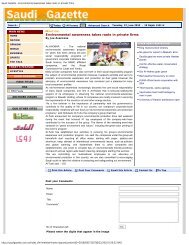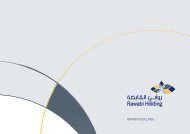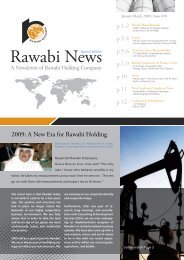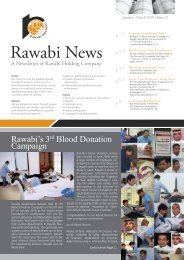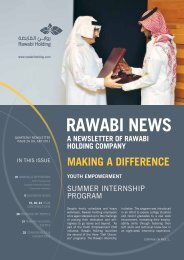Rawabi Holding Magazine Issue 31
Rawabi Holding Magazine Issue 31
Rawabi Holding Magazine Issue 31
Create successful ePaper yourself
Turn your PDF publications into a flip-book with our unique Google optimized e-Paper software.
Business News<br />
Business News<br />
retail<br />
A Closer Look<br />
at the Importance<br />
of Art for Your<br />
Child’s Emotional<br />
Development<br />
By: Vanessa Gallo<br />
Gymboree Play & Music Program Developer and Trainer<br />
One day, Cecilia, a toddler in my<br />
Gymboree Arts class, wanted to<br />
paint with only the color black.<br />
She also made several large, brisk<br />
strokes with her brush and went<br />
through more paper than her<br />
peers. After class, her mother told<br />
me that Cecilia was very upset<br />
that morning about something. It<br />
became evident to both of us that<br />
Cecilia was expressing her anger<br />
through her artwork. In fact, it was<br />
just what Cecilia needed to relieve<br />
her emotions and get on with her<br />
day.<br />
Children, as young as 18 months, begin<br />
to express “self-conscious emotions” that<br />
include complex feelings such as pride,<br />
embarrassment and shame. Regardless of<br />
age, we all need outlets for the emotions<br />
we feel. Many adults read or write to<br />
escape. Some exercise, go for a drive or<br />
talk with a loved one.<br />
Young children are limited in how they can<br />
express their feelings. At the time they<br />
begin to show more complex emotions,<br />
they do not have the vocabulary to express<br />
them. Children primarily showcase<br />
feelings through facial expressions,<br />
gestures and movement or, as in Cecilia’s<br />
case, through painting.<br />
Art experiences are important for your<br />
child’s emotional development. Not only<br />
is art a vehicle for emotional expression,<br />
children also discover how their actions<br />
make an impact on their surroundings.<br />
The process of art provides a great<br />
channel for you to support your child’s<br />
emotional development especially when<br />
you experience art together.<br />
Look What I Can Do<br />
Being able to make an impact on your<br />
surroundings – and know it – is an<br />
important step toward building confidence<br />
and independence. Confidence and<br />
independence contributes to a healthy<br />
self-esteem later in life and the ability to<br />
make better decisions.<br />
Stanford University Art Professor, Elliot<br />
Eisner, has identified several benefits<br />
children gain from art. The first is the<br />
realization that one’s actions create<br />
consequences. He states, “The first<br />
thing that very young children learn is<br />
something that we often take for granted...<br />
they can, in fact, create images with<br />
material and that the activity of making<br />
such images can provide intrinsic forms of<br />
satisfaction.”<br />
Repeated experiences with the same<br />
art materials reap new skills. Using a<br />
paintbrush to apply paint in a new way<br />
or rolling a ball out of dough for the first<br />
time is only achieved through experience<br />
with simple and familiar art materials.<br />
The more your child freely explores with<br />
crayons, paint, and dough, the more<br />
competent he will be.<br />
It is also important that you praise his<br />
processes, not the end products – say,<br />
“I like how you move your paint brush”<br />
instead of “you made a nice picture.”<br />
This, in turn, will support developing<br />
competence.<br />
Art activities should also include several<br />
materials of the same type. For example,<br />
provide plenty of paper and multiple colors<br />
of crayons for your child to choose under<br />
your supervision. Active children may need<br />
to switch out colors often and use a lot<br />
of paper. Your flexibility will support your<br />
child’s need to discover the outcomes of<br />
her actions. The more materials provided<br />
during art activities for toddlers, the better<br />
the experience for expression.<br />
Saving your child’s art and posting it<br />
up – not just on the refrigerator, but in<br />
frames and other important places – will<br />
indirectly communicate that you value his<br />
art creations. Using the work to decorate<br />
cards or gifts will communicate this<br />
message, too. These simple actions on<br />
your part will reiterate the importance of<br />
your child’s ideas and contributions.<br />
There’s Meaning in Mess<br />
Let your child explore with paint. It sounds<br />
easy enough, but for many parents, it’s<br />
hard to let go and allow for mess. The<br />
mess factor involved when young children<br />
create is important and can reveal a lot.<br />
Messes can teach parents about children’s<br />
emotions and can be used as a bridge for<br />
communication.<br />
Often times, the mess children make<br />
results from their excitement as they<br />
engross themselves in the art activity.<br />
It’s also possible that mess making is an<br />
indirect sign of frustration or unhappiness.<br />
By allowing your child to freely explore art<br />
and observing the methods she uses in the<br />
process, you can gain useful information<br />
for opening the doors to communication.<br />
Comment on how she applies the paint<br />
or on the pace at which she colors, and<br />
expand on her reactions – and eventually<br />
her words.<br />
You can minimize the “mess stress” you<br />
feel by ensuring your child has plenty<br />
of room to move. Cover work areas with<br />
newspaper and make available wipes or<br />
towels. Provide child-appropriate utensils<br />
like chunky paintbrushes, shallow paint<br />
containers and large sheets of paper that<br />
support your child’s physical capabilities.<br />
There are also “ready for mess” art<br />
programs you can enroll in, like the<br />
Gymboree Arts program, that provide a<br />
developmentally appropriate place for you<br />
and your child to explore art together.<br />
Sharing in Art<br />
Children aren’t the only “players” in the<br />
game of education. They get more out<br />
of art experiences when interacting with<br />
others. You can expand on your child’s<br />
ideas and introduce new tools when it’s<br />
time for more challenges. By engaging<br />
in child-parent art programs, you add an<br />
important layer of learning to your child’s<br />
education.<br />
Not only is the learning experience<br />
enhanced when children and adults solve<br />
problems together, it is also enriched<br />
when children are actively engaged with<br />
each other. Many children need to observe<br />
each other first before feeling comfortable<br />
enough to try a new art process. It can be<br />
difficult at first when your toddler begins<br />
to express his newfound independence,<br />
especially in a group setting with peers.<br />
However, it is the group setting that allows<br />
opportunity for your child to “socialize.”<br />
Art activities provide tangible tools for<br />
expression. Toddlers enjoy expressing<br />
their independence and use objects to<br />
do so when in the presence of others.<br />
For example, when coloring, the process<br />
of holding onto a crayon as a personal<br />
possession is just as enjoyable as<br />
discovering what it can do. Rest assured<br />
that even if your toddler decides to hold<br />
onto a crayon instead of coloring with it,<br />
he is satisfying an emotional need and<br />
learning something through observation.<br />
Learning to leverage independence around<br />
adults and eventually collaborate with<br />
peers is critical for toddlers. Art provides<br />
a perfect arena to build skills needed for<br />
social competence. Plan opportunities for<br />
you and your child to create with others<br />
and make sure there are plenty of supplies<br />
to go around.<br />
Whether it’s your child’s need for<br />
expression to discover the magnitude her<br />
actions make, or to exert independence<br />
with the materials she selects, art<br />
experiences influence a child’s emotional<br />
development in a unique and valuable<br />
way. In the words of Elliot Eisner, “Art is,<br />
ultimately, not for art’s sake; it is for the<br />
sake of all of us.”<br />
Vanessa Gallo, Program Developer for<br />
Gymboree Play & Music, holds an M.A.<br />
in Developmental Psychology. In addition<br />
to her role at Gymboree Play & Music,<br />
Vanessa serves as a guest lecturer at<br />
San Francisco State University and<br />
has recently published a piece in The<br />
Macmillan Psychology Reference Series:<br />
Child Development. As program developer,<br />
Vanessa led the development of Gymboree<br />
Arts, in addition to other curriculum.<br />
Have you tried<br />
Gymboree yet <br />
Contact us today to book a free trial<br />
in Art or one of our other wonderful<br />
sessions.<br />
Phone us at 038686224<br />
or via our website<br />
www.gymboreeclasses-ksa.com<br />
where you will also find a link to our<br />
Twitter account and Facebook page.<br />
We are also now on Instagram<br />
– find us at Gymboree Khobar and<br />
ask to follow us today.<br />
18 <strong>Rawabi</strong> News <strong>Issue</strong> <strong>31</strong> Oct-Dec 2012<br />
<strong>Rawabi</strong> News <strong>Issue</strong> <strong>31</strong> Oct-Dec 2012<br />
19



